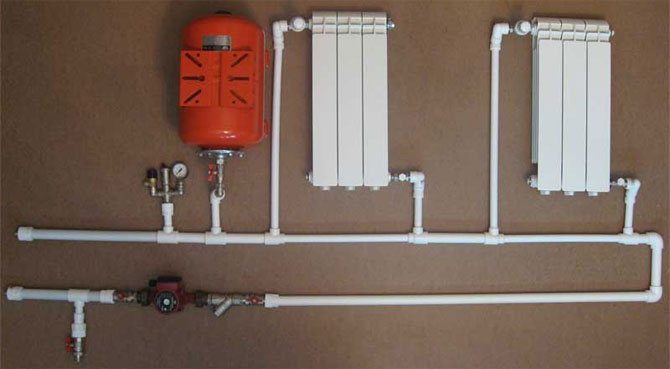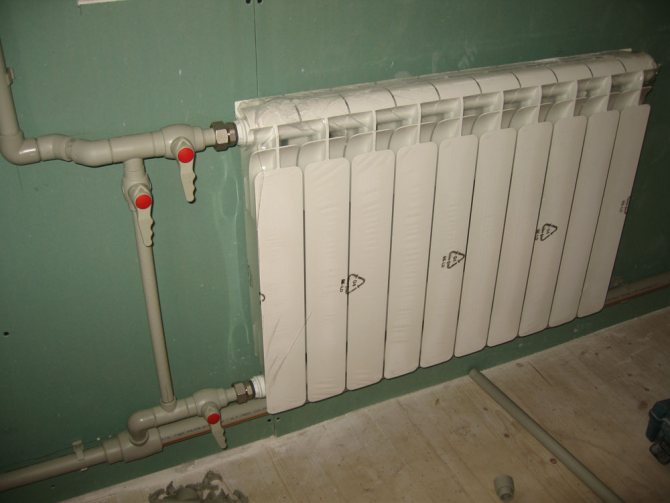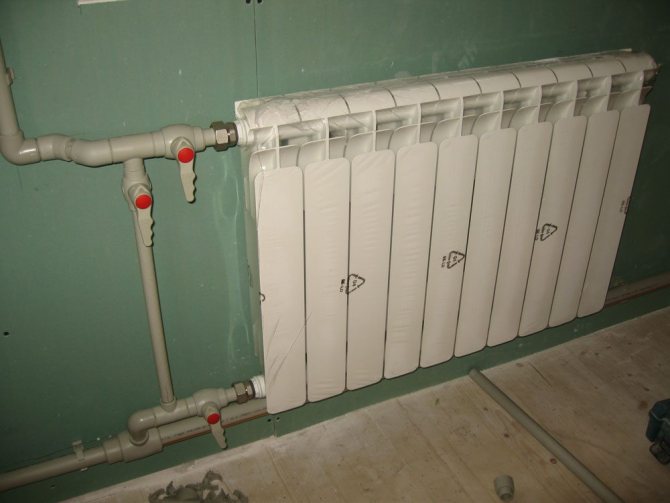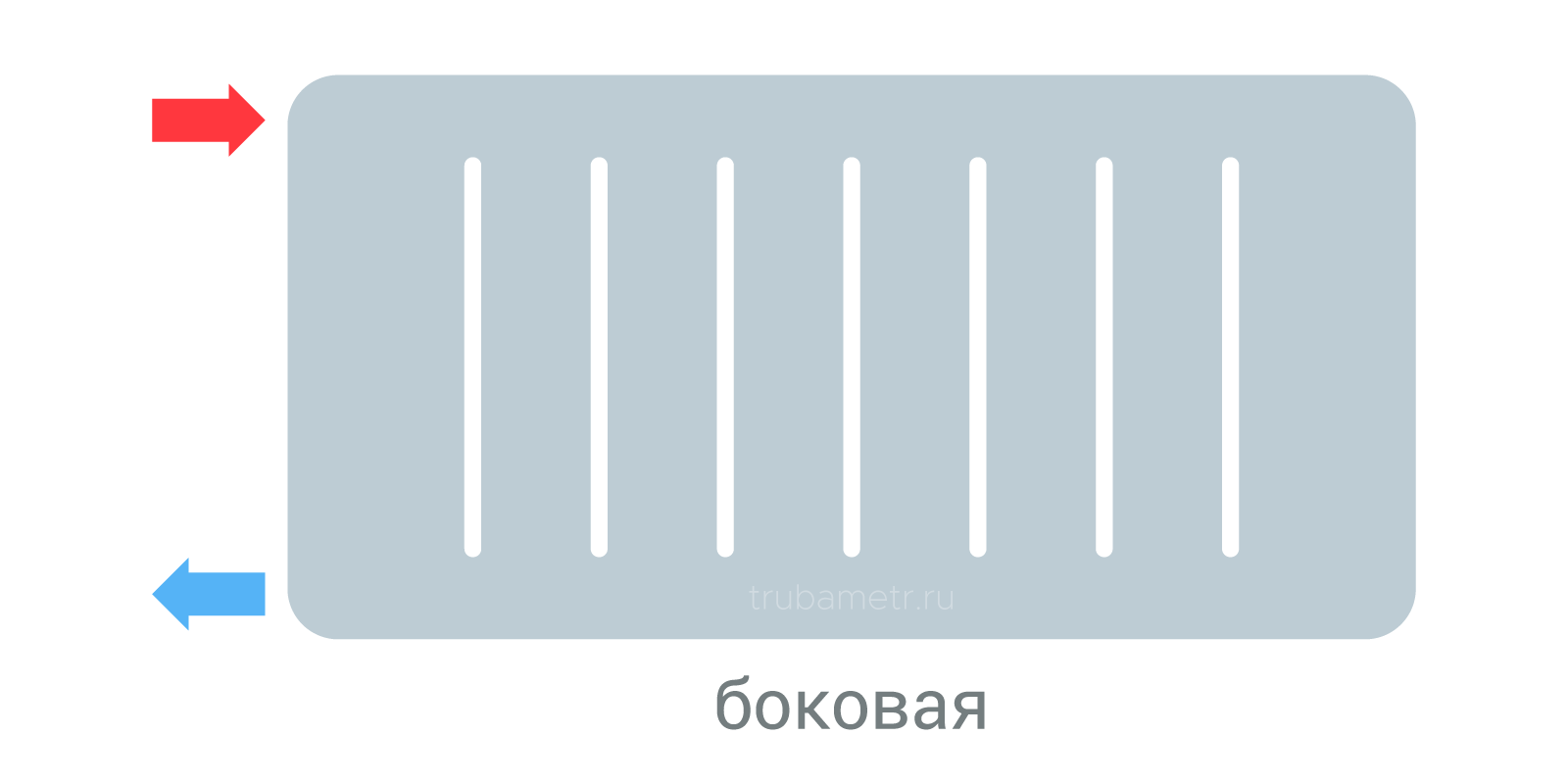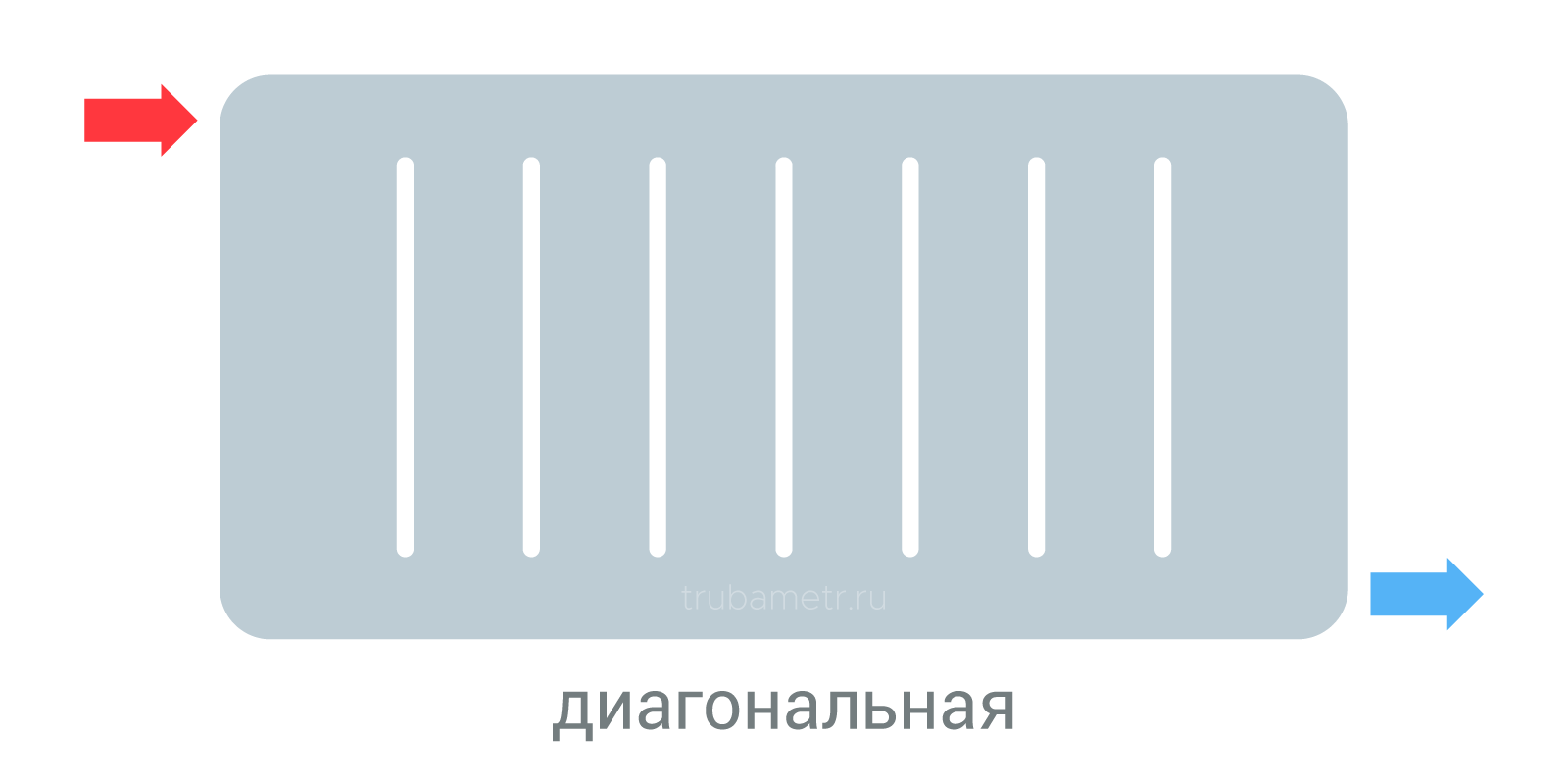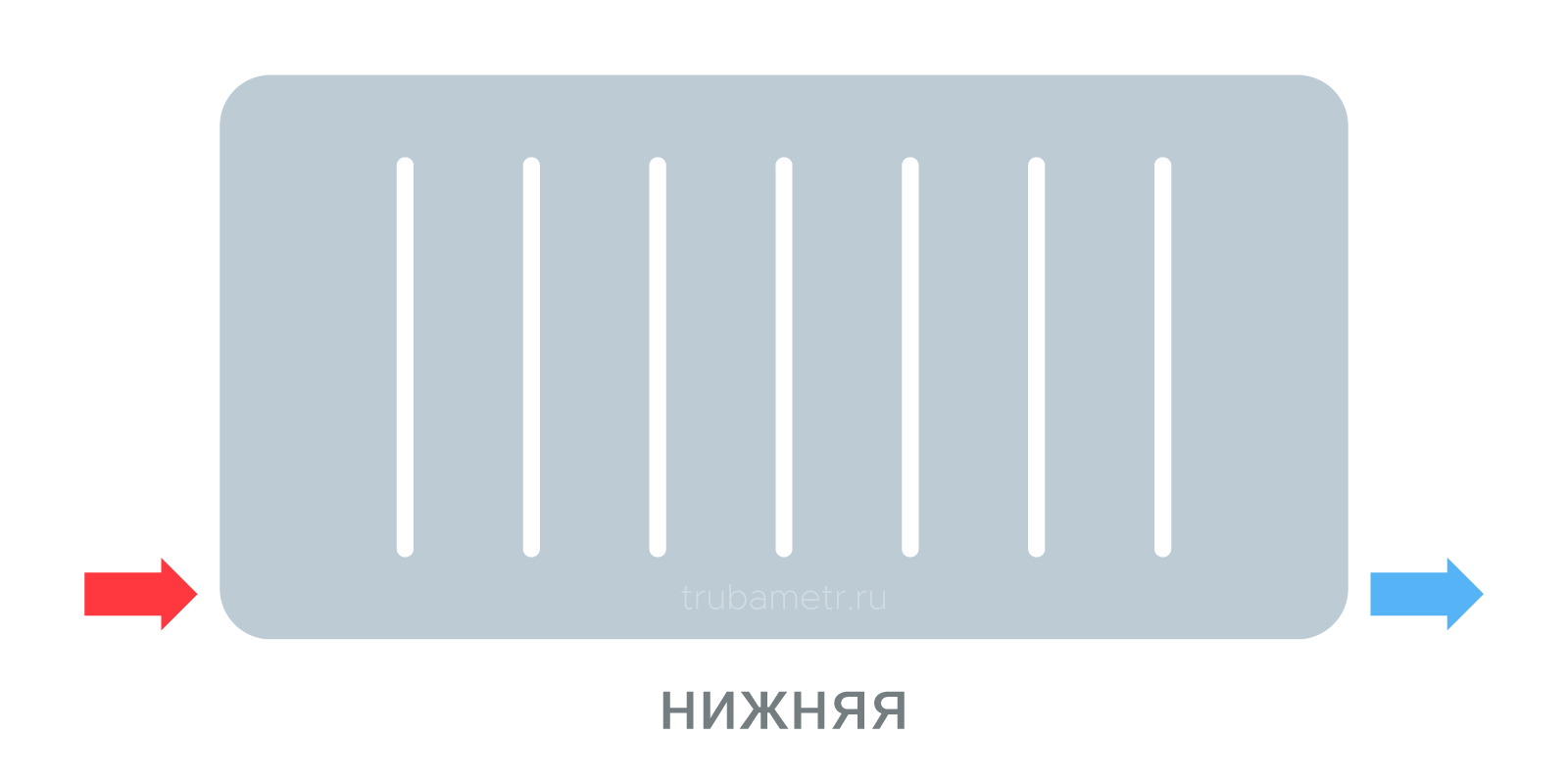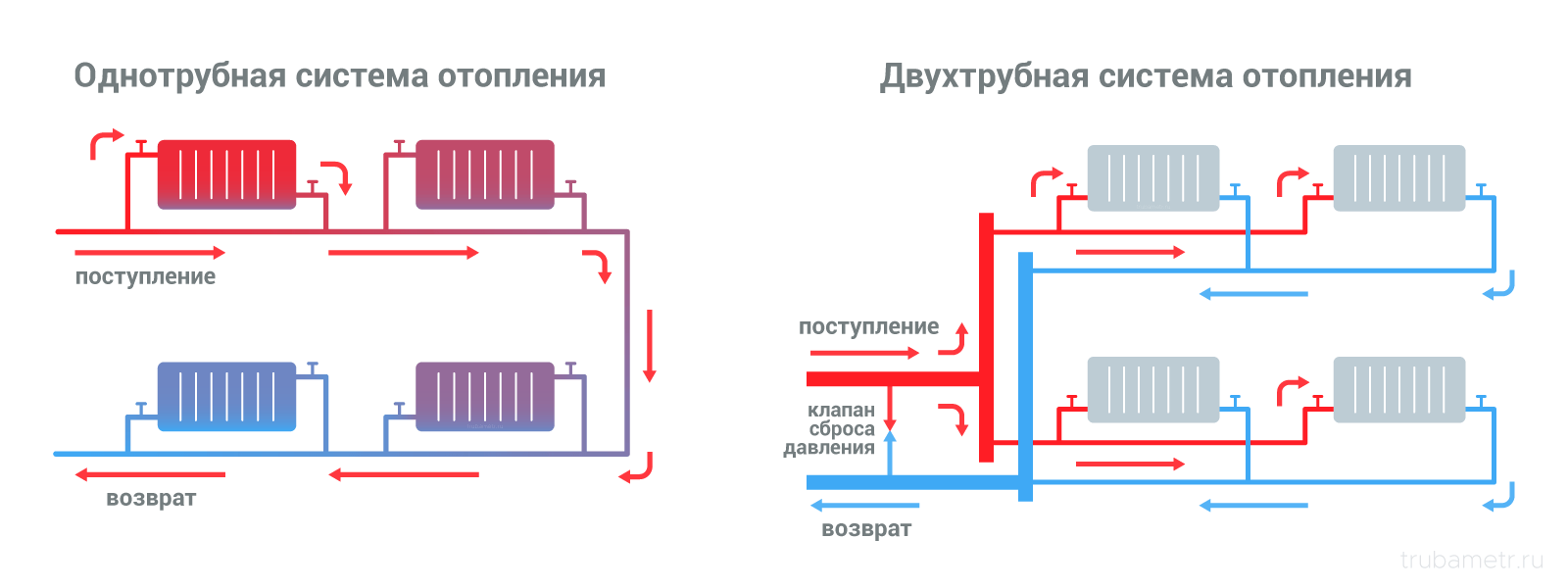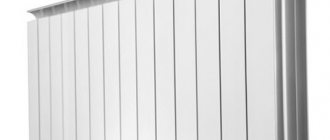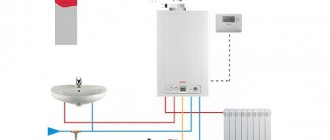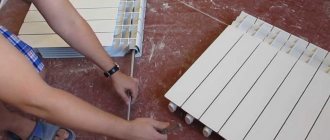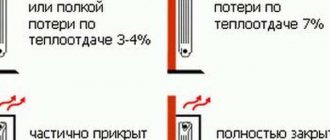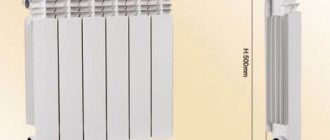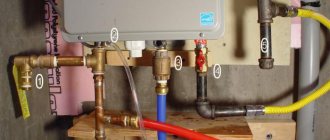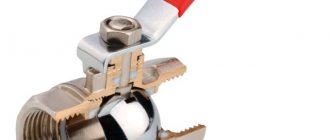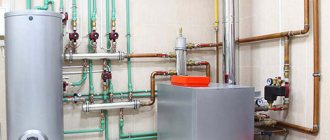DIY heating system installation
Before you cook heating in a private house, you need to stock up on the following tools for soldering polypropylene pipes:
- Shaver that allows you to remove the reinforcement from the soldering area and chamfer the pipe;
- Pipe cutter;
- Soldering iron for polypropylene pipes with a set of nozzles of the required diameter.
The pipe connection technology is as follows:
- First, you need to put the shaver on the pipe and turn it several times to remove the aluminum layer. If this is not done, the metal, upon contact with the liquid, will gradually be damaged, thereby having a negative effect on the entire heating system.
- The soldering iron nozzle is heated to the desired temperature, then a pipe is inserted into the socket, and a fitting is put on the opposite side of the nozzle.
- When the parts melt a little, they need to be combined with some effort and held in this position for a few seconds. After the plastic has solidified, you can proceed to soldering the next section.
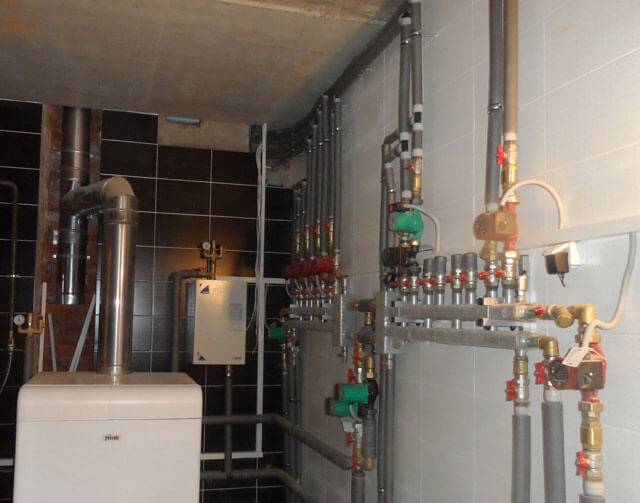
A safety group is installed near the boiler outlet. The place of installation is due to the fact that it is on this section of the system that the pressure rises when the system malfunctions. The expansion tank can be mounted anywhere, but there is one caveat: when installing the tank in front of the pump, the distance between them should be more than two filling diameters, and if the tank is attached behind the pump, then the distance increases to ten filling diameters. Failure to comply with this rule leads to premature failure of the membrane - and it is unlikely that it will be possible to determine the problem immediately, so you will also have to think about how to check the heating in a private house.
Sometimes the question arises as to whether the gravitational system can be converted into forced circulation heating. The answer to this question is affirmative - if necessary, the pump is installed in any circuit, which allows you to completely redo the heating in a private house.
- The diameters and configuration of the wiring are selected so that the system can work with natural circulation;
- In parallel to the wiring, two connections are cut in front of the boiler, to which a circulation pump is connected;
- The tie-ins are separated by a check ball valve.
When the pump is running, the valve closes and completely closes the passage in the bypass, thereby providing forced circulation of the coolant. When the pump is turned off, the heating automatically switches to natural circulation - the valve opens, the coolant continues to move. Of course, the check valve can be replaced with a valve or a ball valve - but in this case, you will have to manually switch the operating mode of the system.
Conclusion
This article gives a superficial idea of how to install heating a private house with your own hands. Each element of the design can be considered in more detail, therefore, if there is such a need, you can search for the corresponding article for a deeper understanding of a specific issue. In general, it can be noted that the heating system has a fairly simple design, and with due attention it can be easily assembled on your own.
Stages of connecting heating radiators
Installing batteries in a house with their subsequent connection requires, depending on the project, a number of auxiliary fittings and components.In this case, the shut-off valves, if they will be installed not on the thread, but by soldering, must also be made of polypropylene. For ease of operation, ball valves are now available in any modification, both straight and angular.
For reference:
Brass fittings can be used, but they are more expensive, and over time, the joints between brass and propylene may lose their strength of the connection.
To make a high-quality connection, you will need the following tools and consumables: seals, a set of keys, thread paste, mounting tape, threads for making threads.


Standard set of tools for connecting heating radiators
Tying is carried out in the following sequence:
connecting fittings of the "multiflex" type - couplings equipped with union nuts are screwed into the radiators;
polypropylene pipes with the help of fastening brackets are mounted on the wall according to the preliminary marking with an allowable gap between the main and the wall of 20-30 mm;
with hidden installation (with laying in a groove), the pipe is brought to the surface only at the points of connection to the radiators;


radiators are attached to the wall using standard brackets or universal pins;
using the so-called soldering iron (optimal power 800 W, operating temperature 270 0 C), the pipeline mounted on the wall with fixed radiators is connected, not forgetting to install, if provided by the project, rod thermostatic regulators.
For reference:
the pipes of the heating circuit must have a slope corresponding to the design, but in the absence of prestressed sections, which over time will turn into a weak link in the heating circuit and can be destroyed by the pressure of the coolant.
To make the idea of installing radiators more visual, we suggest you watch this video.
Battery harness
Before you make your own heating in the house, you also need to think about the amount of fittings that will be used in the system. In the event that it is planned only to turn off the radiators, then two ball valves installed on the connections on each side of the heating devices will be enough. Such cranes are quite reliable and durable, so there will be no problems with them.
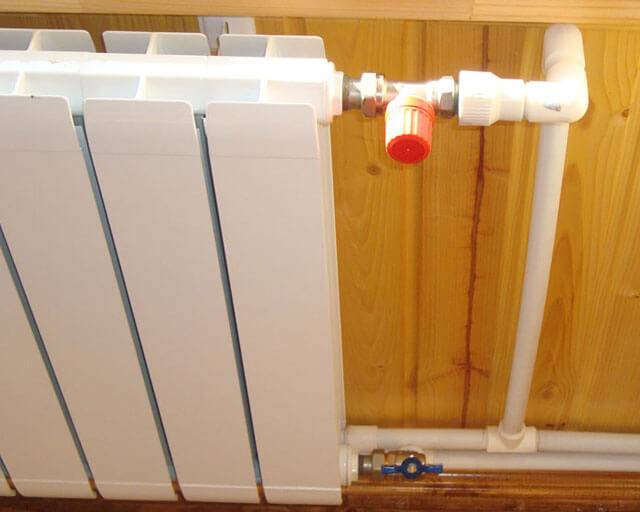

It's another matter if the system needs to be configured. Radiator valves are required to regulate the flow of the coolant. Structurally, they are conventional valves in which a metal valve is installed. To automatically adjust the patency of the connections, it is better to take valves with thermal heads, which regulate the heat transfer of the batteries when the air temperature in the room changes.
Output
In this article, we set out to tell you about the methods of strapping or connecting various types of radiators to the central and autonomous heating system. Of the three methods available - bottom, diagonal and side, the latter is considered the most optimal.
With its help, you can increase the heating efficiency up to 8%, in the rest it drops by about 10%. The video in the article will help you find additional information on this topic.
Did you like the article? Subscribe to our channel Yandex.Zen
Heating distribution
The simplest and most reliable heating wiring diagram is "Leningrad", or one-pipe system wiring. Such a system is constructively a looped loop that runs along the entire perimeter of the building. Radiators are connected to the pipeline in parallel. The main disadvantage of the "Leningrad" is the uneven heating of the radiators connected to the circuit.
A much more effective option for how to properly lay heating, especially in multi-storey buildings, is a two-pipe heating system.Such a system has two varieties, one of which is called a dead-end system. This scheme must be balanced, i.e. restrict the permeability in radiators located close to the boiler - otherwise the heating of the heating devices located far away will not be sufficient.
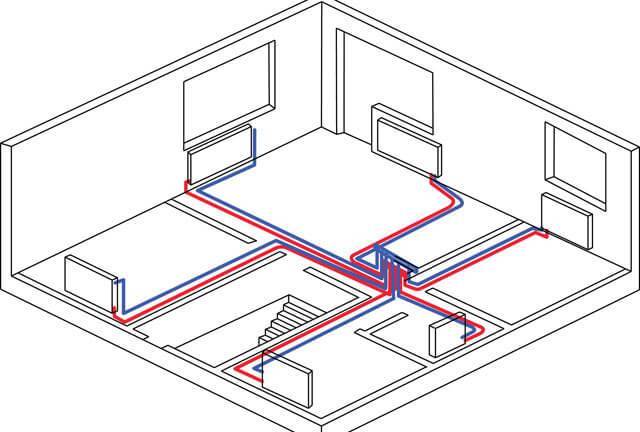

In a passing scheme, there are several parallel circuits of the same length. It is not required to balance the associated wiring, since the heat transfer of all batteries in it is initially almost at the same level. If no obstacles interfere with the creation of a circular passing scheme, then it must be done, otherwise a dead-end two-pipe wiring is quite suitable. In any case, in order to know exactly how to properly lay the heating in the house, you need to think over all the known nuances in advance.
Pipes
What pipes can be used for strapping, and what features should be taken into account?
Steel
She is tied to bimetallic heating devices in central heating systems. Pipe connection method - welding; batteries are mounted on squeegees with threaded fittings.
Important: in central heating systems, a jumper parallel to the riser must be present in front of the valves and throttles on the connections. Otherwise, your throttling valve will regulate the flow of the entire riser.
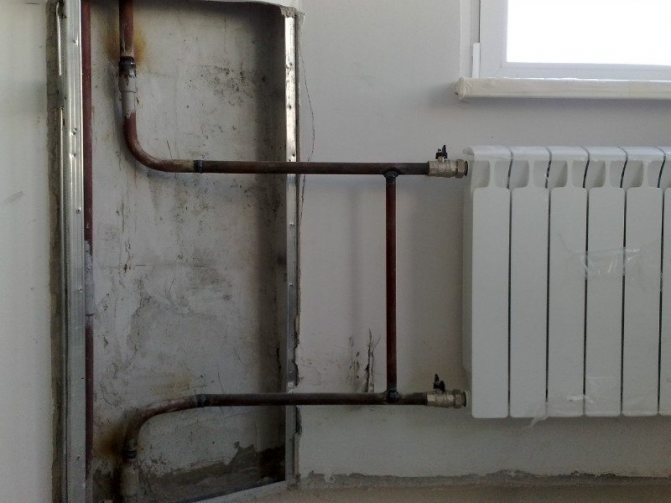

The photo shows the jumper in front of the valves.
Galvanized steel is worth mentioning separately. It is considered unsuitable for heating material, and absolutely undeserved. Among other things, galvanizing was used to strap cast-iron heating radiators in stalinkas built in the middle of the last century; these pipes do not differ from new ones even now.
The only drawback of galvanizing is that all connections have to be made threaded: zinc that burns out at the welds makes the pipe vulnerable to corrosion.
Metal-plastic
Strapping heating radiators with metal-plastic pipes is possible, but with several restrictions.
- It is applicable only for autonomous systems with their limited pressure.
- It is advisable to use press fittings.
- If compression fittings are used, the use of a calibrator is mandatory. Otherwise, when the pipe is aligned with the fitting, the rubber O-rings on the fitting will tear up, which leads to leakage after several heating and cooling cycles.
Polypropylene
Tying heating radiators with polypropylene can also be, with a light heart, recommended only for autonomous circuits.
And there are a couple of restrictions here:
- Reinforced pipes with working pressure PN25 are preferred.
- Long straight sections of the spill are equipped with expansion joints - annular or U-shaped bends, which dampen the elongation of the spill when heated.
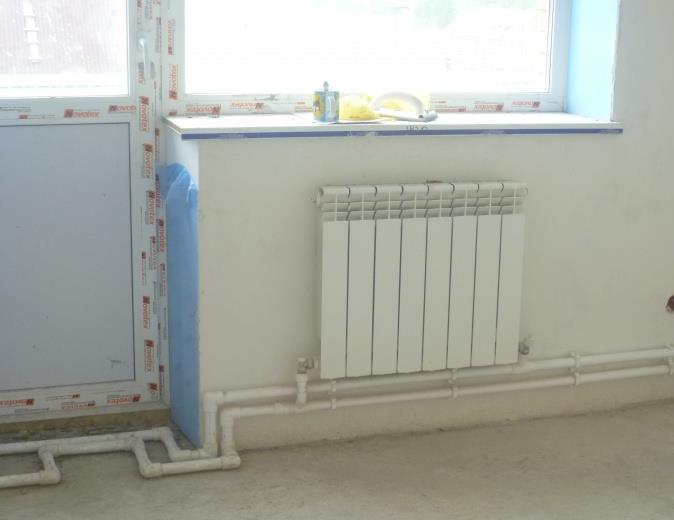

The piping schemes for heating radiators with polypropylene should include expansion joints in straight sections.
Heating boilers
The choice of a heat source is a key factor on which the further selection of heating elements and the efficiency of the assembled system will depend. The cheapest fuel today is gas, therefore, if a gas main is connected to the site, a gas-fired boiler will be the best solution.
Condensing gas boilers with electric ignition proved to be the most economical ones, which have a couple of features:
- When the coolant is heated to too high a temperature, the gas is simply not consumed, which reduces its costs by about 25%;
- The heat given off to the steam is also used for heating, which saves another 10-12% of the energy resource.


If we arrange heating equipment operating on other types of fuel in order of decreasing efficiency, we get a list of the following type:
- Wood-fired boilers;
- Pellet boilers;
- Coal boilers;
- Diesel boilers;
- Electric heating devices.
When choosing a heat source before heating in a private house, you need to pay attention to a number of nuances:
- For gas boilers, you can use not only main gas, but also bottled gas. True, the cost of heating in this case increases several times.
- Before purchasing a heating device running on a certain type of fuel, it is worthwhile to at least roughly study the dynamics of price increases for different types of fuel, and when studying, it is necessary to tie fuel prices to geography.
- Coal boilers use firewood for kindling. This must be taken into account - firstly, kindling and warming up the system will take more time, and secondly, the purchase of firewood will require additional costs.
- Gas, diesel and electricity boilers function smoothly in the presence of fuel. Pellet boilers with an automatic feeding system can work for a week. Solid fuel boilers must be heated and cleaned at least (and often more often) once a day. A long-burning boiler can work on one tab for several hours longer, and the most expensive and modern devices work without problems throughout the day.
- Development can be used as fuel for diesel boilers - this will reduce heating costs by several times. The disadvantage of such savings is the scarcity of used oil, which is very difficult to obtain in sufficient quantity and on a consistent basis.


Electricity in such devices is required only for the operation of the compressor. Such schemes turn out to be quite profitable - the cost of heating can ultimately compete on an equal footing with the savings when using solid fuel boilers and gas.
Of course, you have to pay for the savings somewhere - the cost of heat pumps is very high, and the installation of such equipment costs a round sum. It is enough to give a simple example: to install a geothermal pump, you need to drill a well several tens of meters deep, or dig a pit, the area of which will be three times the area of the heated building.
There is a solution to this problem - you can use a type of heat pump in which the air outside the house is the coolant. Heat energy is pumped out of it, which is used later to heat the building. In fact, such a scheme represents the operation of a conventional air conditioner set to heating mode.
Place of radiators in the heating system
The use of radiators in heating residential premises is of key importance today. Not all residential buildings, especially apartments in multi-storey buildings, can be converted to underfloor heating. Therefore, the main work on heating internal living spaces is performed by radiators or good old and familiar to us, batteries.
Radiators transfer thermal energy from the coolant to the surrounding space. Heat transfer is carried out due to the large heating surface of the heating device. In modern models, there are a number of technical improvements, thanks to which it became possible to connect in a wide variety of options and for any wiring diagram.
Note: in the old cast-iron and steel batteries there was only one upper and one lower branch pipes through which hot water is supplied and the return flow is output.
We offer you to familiarize yourself with Calculation of sections of aluminum radiators per square meter
In modern models, in addition to the main supply and output nozzles, there are built-in air vents. This design of the batteries radically changed the quality of the functionality of the heating system. If there are air locks in the heaters, it is enough to open the drain valve and bleed the air.
In many ways, thanks to modern models of heating batteries, it has become possible to choose the most convenient connection scheme, to install heating devices in those places in the living quarters in which they are most effective. The quality of the heating water circuit depends on the correct piping. The process is necessary if you are using piping made from polypropylene pipes.
Important! In the presence of metal risers, the strapping is made from other consumables. It can be metal copper pipes or metal-plastic. The use of polypropylene pipes in this case is strictly prohibited.


The reason for the incompatibility of metal pipes with polypropylene products is the presence of a threaded connection. Considering the fact that propylene pipes have a high coefficient of thermal expansion, when hot coolant is supplied, the threaded joint will lose its tightness and stability. Therefore, if you want to connect a heating radiator made of polypropylene pipes, try to use fittings, adapters and couplings made of similar materials.
Note: the difference in diameters of pipes made of different materials should be taken into account.
Today, two heating systems are used that can be used to install heating radiators in a house: one-pipe and two-pipe
One pipe diagram for connecting a heating radiator.
A single-pipe system is heating, in which hot water enters the entire building, flows from top to bottom through pipes and heating devices that are installed in individual apartments. This system is quite common today, it is used for apartment buildings. But it is this installation method that has significant drawbacks:
- there is no way to regulate the temperature of heating equipment (in rare cases, there is a chance to install an additional expensive system);
- the temperature is higher on the upper floors than on the lower ones;
- if repair work is necessary, the entire riser is turned off;
- completely disconnecting from the central heating system is rather difficult.
The two-pipe system for connecting heating radiators is the supply of hot water through one pipe, and already cooled down through the other (this is the so-called return flow). All radiators with such a system are connected only in parallel. A two-pipe heating system is used for private houses, cottages.
It is not only very convenient and efficient, but also has such advantages as the ability to adjust the temperature of the radiators, which will be the same for all batteries, regardless of the number of storeys.
Two-pipe diagram for connecting a heating radiator.
- heating radiators with a plug at the bottom and a valve at the top;
- radiator cap;
- thermostat and valve (for two-pipe system);
- stopcock;
- shank;
- bypass (for two-pipe system);
- couplings and locknuts for fastening heating radiators;
- risers in the form of heating pipes (can be made of polypropylene, polyethylene, metal).
Choice of pipe diameter
Another important issue that needs to be decided in advance is how to carry out the heating and with what pipes. It is necessary to select pipe diameters depending on what kind of heat transfer is planned for a certain section of the heating circuit. For example, on the wiring, this value corresponds to the power of the boiler, the connections to the radiators must transmit enough coolant to heat the radiators themselves, and the throughput of the risers must ensure the normal heat transfer of all heating devices connected to them.
In principle, if it is possible to increase the circulation rate of the coolant (by increasing the pump power), the diameter of the pipes can be reduced
But in this moment it is important not to overdo it - the acceleration of the coolant leads to an increase in noise in the system. The standard speed is about 0.4-0.6 m / s.


When using a gravitational heating system, the diameter of the distribution pipes must be increased by at least one step. It's all about the very low pressure inherent in systems with natural circulation of the coolant. Too wide pipes will reduce the hydraulic resistance of the circuit, sometimes up to a complete loss of system performance. Knowing such points is already a large part of the answers to questions about how to make efficient heating in a private house.
Fixing to the floor
Not all walls can support even lightweight aluminum batteries. If the walls are made of lightweight concrete or plasterboard, a floor installation is required. Some types of cast iron and steel radiators come immediately on legs, but they do not suit everyone in appearance or characteristics.
Feet for installing aluminum and bimetallic radiators on the floor
Possible floor installation of aluminum and bimetallic radiators. There are special brackets for them.
They are fixed to the floor, then the heating device is installed, the lower collector is fixed with an arc on the installed legs. There are similar legs with adjustable height, there are fixed ones. The method of fastening to the floor is standard - with nails or dowels, depending on the material.
How to connect a heating radiator with a polypropylene pipe
Connecting a radiator to polypropylene pipes is a process consisting of several stages:
- Drawing up a drawing, marking.
- Fastening batteries to walls with brackets.
- Installation of pipes, connection of individual parts.
- Pipeline testing.
There are several ways to connect the battery to the pipes:
- Bottom connection. The pipes are connected on both sides of the radiator at the bottom. Suitable for horizontal installation of a single-circuit pipeline.
- Side connection. On one side of the battery there are two openings for the fluid supply, the outlet of the working off.
- Diagonal connection. The classic version of connecting radiators to pipes. The openings for supply and outlet of the coolant are located on two sides in the lower and upper parts.
Options for piping heating radiators
The installation of heating radiators implies their connection to pipelines. There are three main ways to connect:
- saddle; one-sided; diagonal.
Connection options
If you install radiators with the bottom connection, you have no choice. Each manufacturer rigidly binds the supply and return, and its recommendations must be strictly followed, since otherwise you simply will not get heat. There are more options with side connection (more details about them are written here).
How to make the boiler piping correctly
The next component of the heating system is the boiler piping. The first step is to look for a circulation pump with good performance. If it can deliver a pressure of 2 meters, then such a device is quite suitable even for the functioning of heating in multi-storey buildings.
The power of the circulation pump is calculated using a formula of the form:
- Q = 0.86R / Dt, where
- Q - pump performance (measured in cubic meters per hour);
- R is the power of the heating boiler or circuit into which the circulation pump will be built;
- Dt is the temperature difference in the supply and return circuits (usually about 20 degrees).
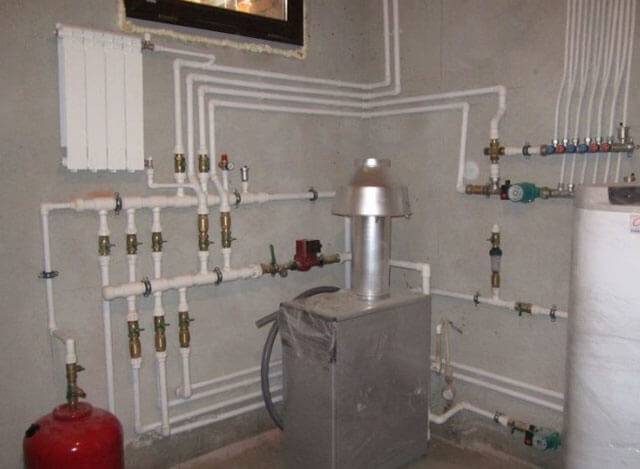

When choosing a safety valve, you need to build on the maximum pressure that can occur in the system (as a rule, this value is 2.5 kgf / cm2). The volume of the expansion tank should be 1/10 of the volume of the coolant in the circuit. It is advisable to take a tank with a small margin.In standard heating systems, about 15 liters of coolant are needed per 1 kW of boiler power.
As a rule, the tank starts to operate at a pressure of 1.5 kgf / cm2 - i.e. when the operating pressure is exceeded in a balanced heating system. To increase the pressure, you need to use a tap connecting the heating and cold water supply, or simply pump up the expansion tank with air.
Plug
The radiator has four outputs with side connection.


Two of them are occupied by the supply and return pipelines, on the third they are installing a Mayevsky crane. The fourth entrance is closed with a plug. She, like most modern batteries, is most often painted with white enamel and does not spoil the appearance at all.
Where to put the plug and the Mayevsky tap with different connection methods
Strapping methods
To mount a battery harness in a private house or city apartment, you will need:
- shut-off valves, which are most often used the simplest ball valves;
- plugs to cover the remaining channels;
- Mayevsky taps, allowing to bleed air from the system during seasonal start-up of equipment;
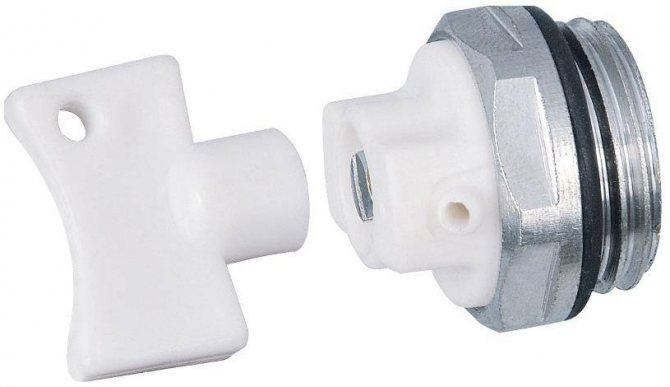

A device for removing air from the heating system
sealing material.
Additionally, you can install on any heating radiator:
- a pressure gauge that determines the pressure in the system (most often used when installing equipment in autonomous country houses);
- thermostat operating in manual or automatic mode. With this equipment, you can set a specific temperature for any individual radiator.
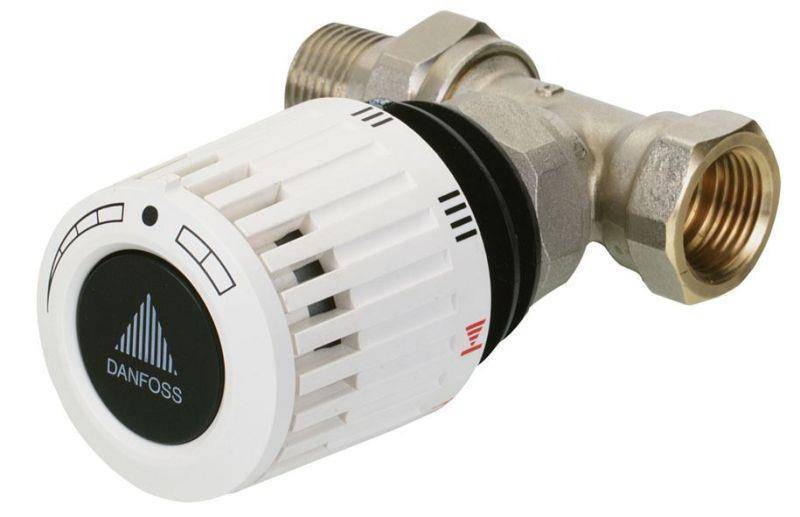

Device for setting a specific mode of battery operation
If the strapping is carried out with polypropylene, then additional welding equipment is required.
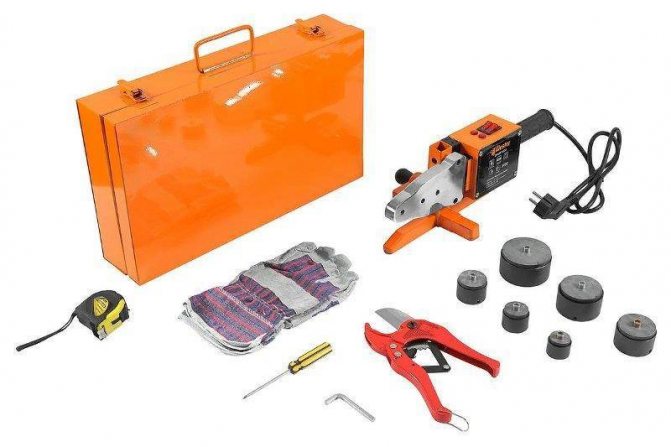

Device for welding polypropylene pipes
So, depending on the factors presented above, the piping of the heating radiator can be performed according to the following schemes:
- for side connection;
- for diagonal connection;
- for bottom connection.
Side connection strapping
With a lateral connection method and a one-pipe system, the piping is installed as follows:
- ball valves are installed on the inlet and outlet nozzles, which make it possible to shut off the coolant supply for repair or maintenance work;
- taps are connected to tees;
- a piece of pipe is inserted into the remaining taps of the tees, which acts as a bypass.
A bypass is required for autonomous shut-off of a separate radiator, for example, for repairs, without shutting down the entire heating system.
With a lateral connection to a two-pipe system, work is carried out in a similar manner. However, a bypass is not required in this situation.


Strapping diagrams when choosing a side battery connection method
Diagonal connection strapping
The connection of the radiator to the pipes with a diagonal connection is as follows:
- the inlet pipe is connected to a pipe cut, no longer than 10 cm - 15 cm;
- then a ball valve and a tee are installed to connect the bypass;
- the outlet pipe is connected to the elbow and only after that it is connected to the pipeline that removes the coolant;
- a crane is installed before connecting to the central line.
When connected to a two-pipe system, the operation is the same except for the bypass.
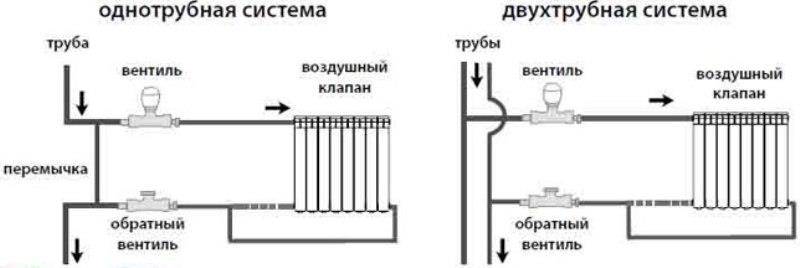

Battery strapping diagram when choosing a diagonal connection method
Bottom connection strapping
The strapping of the lower connection method is simpler than all the others:
- shut-off valves are connected to the inlet and outlet of the radiator;
- pipe bends are introduced into the central lines. If necessary, special adapters - angles or tees - are installed at the bend points.


Radiator piping diagram with bottom connection method
There is a separate nuance when tying the bottom connection when connected to a one-pipe system. In most cases, the connection is made as shown in the figure, that is, without a bypass that allows autonomous shutdown of the heater. But if you want to use the device, you can install it. For this, an additional piece of pipe is installed between the flanges of the inlet and outlet pipes.


Bottom connection piping using bypass
The following video is devoted to a detailed description of the types of piping of batteries in the heating system.
Thus, with the correct choice of connection method and correct installation, the heating system will serve for a long time, evenly heating all rooms.
Strapping with one-way connection
One-way connection is most often used in apartments.
It can be two-pipe or one-pipe (the most common option). In apartments, metal pipes are still used, therefore, we will consider the option of tying the radiator with steel pipes on squeegees. In addition to pipes of a suitable diameter, two ball valves, two tees and two squeegees are needed - parts with external threads at both ends.
Lateral connection with bypass (one pipe system)
All this connects as shown in the photo. With a one-pipe system, a bypass is mandatory - it allows you to turn off the radiator without stopping or lowering the system. You cannot put a crane on the bypass - you will block the movement of the coolant along the riser with it, which is unlikely to please your neighbors and, most likely, will be fined.
All threaded connections are sealed with fum tape or linen tape, on top of which packing paste is applied. When screwing the tap into the radiator manifold, a lot of winding is not required.
Too much of it can lead to the appearance of microcracks and subsequent destruction. This is true for almost all types of heating devices, except for cast iron. When installing all the others, please, no fanaticism.
Welded option
If you have the skills / ability to use welding, you can weld the bypass. This is how the piping of radiators in apartments usually looks.
With a two-pipe system, a bypass is not required. The supply is connected to the upper input, the return is connected to the lower one, taps, of course, are needed.
One-sided piping with two-pipe system
With lower wiring (pipes are laid on the floor), this type of connection is done very rarely - it turns out to be inconvenient and ugly, it is much better in this case to use a diagonal connection.
Selection of the type of strapping
The piping scheme for heating system radiators is selected based on the following factors:
- the type of system that supplies heat to the room;
- method of connecting the radiator with central highways.
Determining the type of system
Before proceeding with the selection of piping for heating equipment, it is necessary to determine the type of room heating system. The following types are currently used:
- one-pipe systems;
- two-pipe systems.
One-pipe heating is a system in which all heating equipment is connected by one pipe. The coolant sequentially enters each radiator and returns to the boiler along one closed loop.
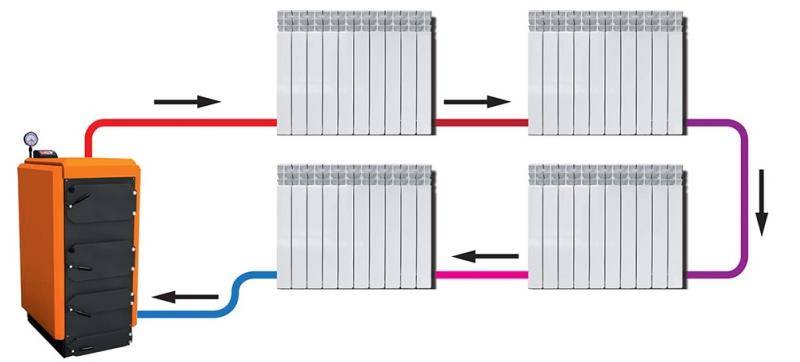

Heating system with one closed circuit
The advantages of a one-pipe heating system are:
- balance of the system, which allows to achieve uniform heating of all connected radiators;
- increased heating rate;
- aesthetic appearance and minimal amount of occupied space;
- ease of installation;
- saving on materials.
The disadvantages include:
- the interconnectedness of all elements of the system, which leads to the impossibility of performing repair work on one of them without disconnecting the other;
- the complexity of regulating the temperature of the coolant;
- the need to install a pump with a high power rating.
Two-pipe heating includes two main pipelines. One delivers the coolant to the radiators, and the second returns to the heating equipment.


Heating network with two main pipelines
The advantages of such a system are:
- the same temperature of all radiators, since the coolant is supplied to a separate battery directly from the heater;
- the possibility of constructing a system with a lower internal pressure, which allows the installation of equipment of lower capacity.
The most significant disadvantage is the cost of the system. It is generally accepted that the cost of purchasing materials increases by 2 times. In fact, this statement is incorrect, since with a one-pipe system, fewer pipes are required, but with a larger diameter, and for a two-pipe system, vice versa.
A single-pipe heating system is organized in almost all old apartment buildings. It is also advisable to install it in country houses with an area of up to 150 m². A two-pipe system is being installed in new houses and country cottages.
Connection options
The methods of connecting radiators also depend on the location of the pipes in a private or apartment building. Allocate:
side connection, in which the inlet and outlet pipes are located on the same side of the radiator. This type is distinguished by minimal costs for the arrangement of the connection (serial connection), aesthetics and minimal losses of thermal energy. Typically used in most apartment buildings;
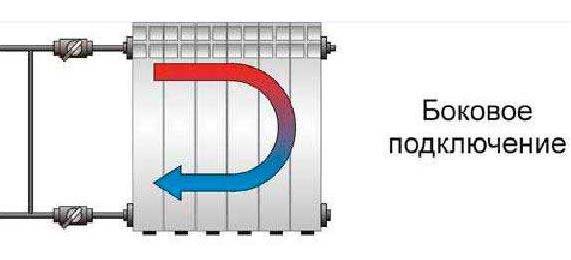

Radiator side connection
diagonal connection. Unlike the previous case, the input and output are located on opposite sides of the heating batteries. The main advantage is the possibility of uniform heating of radiators with a large number of sections (from 12 pieces);


Diagonal battery connection
bottom connection - inlet and outlet pipes are supplied from the bottom. The advantages of this method are aesthetics and the ability to mount highways to the floor or wall. The disadvantages include significant losses of thermal energy, which are at the level of 1% - 15%.
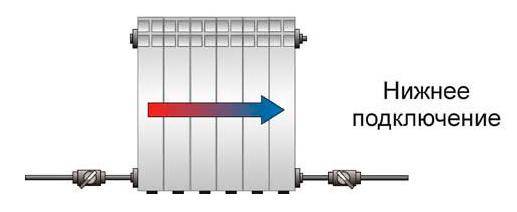

Bottom heater connection
Tying radiators with polypropylene pipes
The piping of heating elements is the main stage in the installation of a heating system. The essence of the process is the installation of special equipment that will regulate the heat transfer process. With its help, the battery is disconnected in case of accidents, replacement of system elements and its flushing.
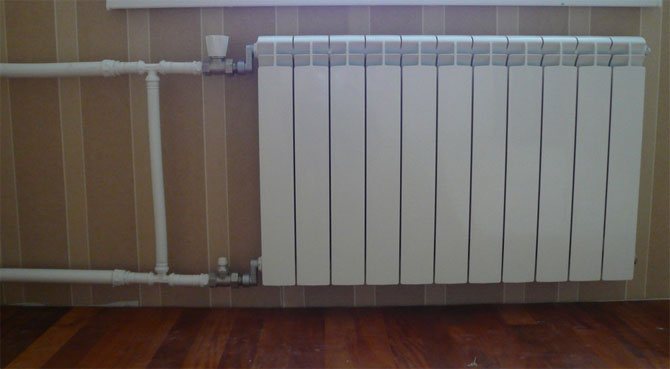

For high-quality installation of the heating system and its efficient operation, you should purchase shut-off valves, fittings, installation tools.
Shut-off valves
It is necessary to install shut-off valves on polypropylene pipes at the inlet and outlet of the coolant.
Types of valves when connecting polypropylene pipes to heating radiators:
- Valves (ball valves recommended). Conventional valves are installed on the inlet and outlet pipes directly in front of the batteries. With a single-circuit system, an additional valve will be required for the jumper between the return and supply (bypass). The valves are used to shut off the flow of the coolant, if necessary, when the system is running. It is impossible to restrict the supply of coolant to the radiator with a ball valve - setting it to an intermediate position leads to the destruction of the valve.
- Chokes are special valves that regulate the supply of coolant to the radiator. The choke will allow you to manually limit the heat dissipation. It takes up to 2 hours between closing the valve and the temperature drop in the room.
- Chokes with a thermostat (thermostats). Such devices independently regulate the supply of the coolant, depending on the specified parameters.These devices allow you to maintain an even air temperature regardless of weather fluctuations.
Types of radiators for strapping
To install a heating system, you must select the type of radiator. Different types of heating equipment differ in terms of fastening to the wall, materials of manufacture, connection of pipes. Manufacturers today offer the following options:


Sectional radiators device.
- Panel steel batteries in the form of relatively thin solid panels. The connection of such radiators can be side or bottom.
- Lightweight sectional made of aluminum. Bimetallic ones are also often used. Such batteries can be connected in one or several sections, the connection with the common system is lateral, polypropylene pipes are ideal.
For apartments with central heating, bimetallic radiators are used (cast iron radiators are used less and less, this is due to their heavy weight, bulkiness, fragility). This is due to the fact that the water supplied to the heating system often contains alkali, sand, which can damage other types of radiators.
For a private house, aluminum, steel panel radiators are perfect, while all the conditions for connection must be observed (for a copper pipeline, steel and aluminum radiators are used, for a conventional one - only aluminum is possible).
Types of modern radiators
Heating models of the new design are systems in an ergonomic design. They differ in the method of fastening, material and connection diagram to the thermal circuit.
Manufacturers produce the following popular types of batteries:
- Tubular or sectional steel appliances. Both types of devices are characterized by the same heat transfer. Tubular models are more attractive and cost more.
- Aluminum devices with better heat transfer. They are used in systems with a neutral heat carrier. An environment with high alkalinity and acidity will negatively affect the devices.
- Bimetallic radiators made of aluminum and steel at the same time. They have all the advantages of the first two types of batteries. These models are resistant to sand particles and alkali. Therefore, their price is higher than other devices.
In private houses, installation of any radiators is carried out. In apartments, bimetallic sectional batteries are more often installed.


Installation of bimetallic radiators on polypropylene pipes
After all, they have to be connected to the central heating network, which often moves the coolant with high alkalinity.
Armature
Locking
Connecting aluminum radiators with polypropylene pipes implies that they are equipped with shut-off valves. Which one and why?
The simplest and cheapest option is a pair of valves. Better - ball: unlike screw and cork, they are extremely reliable, always remain tight and do not require maintenance. The valves perform the only function - they allow, if necessary, to completely turn off the heater for repair or replacement.


The battery is equipped with a pair of ball valves.
An advanced option is to equip the battery with a choke or a pair of chokes.
What are they needed for?
- The choke allows you to manually reduce the heat dissipation of the device at high room temperatures.
- A pair of throttles are used in cases where the two-pipe system requires not only adjustment, but also balancing - limiting the flow through the radiators closest to the boiler or pump. For balancing, a throttle on the return line is usually used, to regulate the temperature in the room - on the supply.
Finally, the most convenient (but also the most expensive) option in terms of ease of use is the connection of the radiator with a polypropylene pipe using a thermostatic valve and a thermal head.
The thermostat uses the already familiar temperature expansion of some media: when it heats up (and increases the linear dimensions of the bellows in the thermal head housing), it closes the valve, limiting the flow of the coolant; the valve opens when it cools down.This ensures a constant temperature in the room with any change in external conditions - the weather outside or the parameters of the coolant.
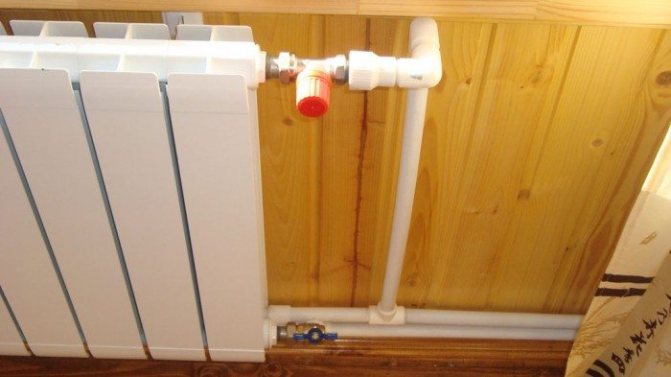

The thermostat must not be located in the upward flow of warm air from the radiator or piping.
Note: in a two-pipe heating system, the thermostat is often equipped with a balancing throttle on the second connection.
In addition to shut-off and control valves, at the bottom connection, the radiators are equipped with air vents - valves for bleeding air after the circuit has been reset.
The role of air vents can be:
- Mayevsky's cranes. Their advantages are compactness and low cost.
- Regular valves or water taps installed in the upper drain plug of the radiator. They are convenient for their high flow capacity: air is released through the valve much faster.
- Automatic air vents that remove air bubbles from the circuit without the participation of the owner.
Fitting
What fittings and how to connect a heating radiator with a polypropylene pipe?
- Tapping into horizontal filling is performed through a union tee with a diameter transition. Typical dispensing diameters in a reasonably long, forced circulation circuit - 25 - 32 mm; the outer diameter of the connection to a separate heating device is 20 mm.


The tapping into the filling is made with socket welded tees.
- 1/2 ”weld to thread adapters allow connection of valves, throttles or thermostatic valves.
- To connect the shut-off valves with radiator plugs, American women are used - quick-disconnect fittings with union nuts and rubber gaskets. They can reduce the time for dismantling the radiator to 30 - 45 seconds.
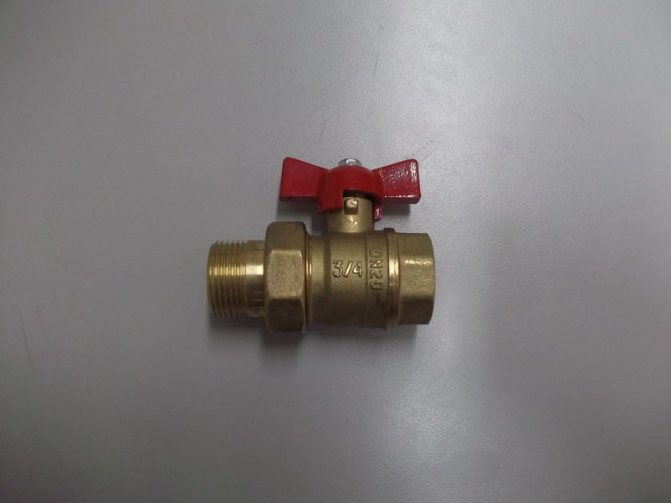

The photo shows a combined solution: a ball valve with an American.
Choice of materials
The popularity that polypropylene pipes have gained is associated with a number of their positive qualities:
- The price for them is significantly lower than for the iron counterparts.
- High durability, due to the fact that the plastic does not rust, moreover, there is virtually no sediment deposited on it.
- Do not need painting.
But, it should be taken into account that not all types of polypropylene pipes are suitable for heating systems. The fact is that they must necessarily have a reinforcing layer that prevents large thermal expansion of the pipeline.
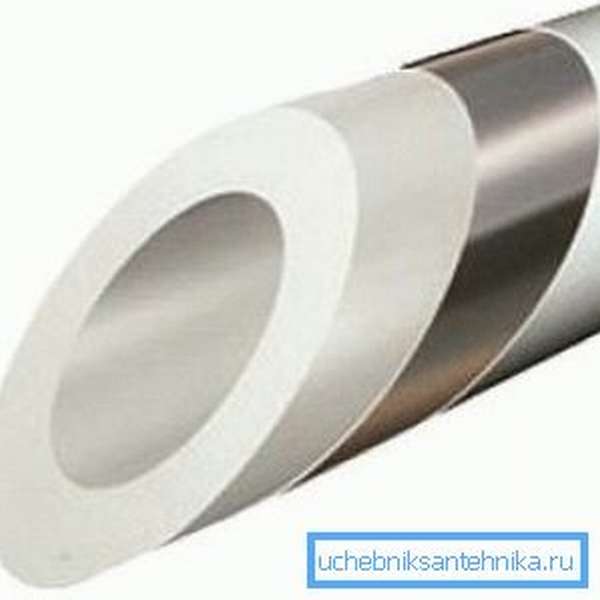

Moreover, it is necessary that the reinforcing layer be aluminum, since the fiberglass reinforcement leads to the saturation of the coolant with oxygen. This, in turn, leads to rusting of the iron surfaces of boilers and other heating elements. Pipes that have aluminum reinforcement and are suitable for heating systems are designated PN25.
Note! When choosing pipes, pay attention to the uniformity of the thickness of their walls. To do this, you need to look at their cut.
As for the diameter, the optimal parameter is 25 mm.
Along with this, in addition to this, you need to buy fittings, which include:
- Couplings,
- Angle adapters,
- Ball Valves.



